Organisational Behaviour: Influence of Culture, Politics, and Power
VerifiedAdded on 2022/12/28
|14
|4324
|28
AI Summary
This report explores the influence of culture, politics, and power on organisational behaviour. It discusses the components of organisational behaviour and provides a case study on Morrisons, the largest supermarket chain in the UK.
Contribute Materials
Your contribution can guide someone’s learning journey. Share your
documents today.

ORGANISATIONAL BEHAVIOUR
Secure Best Marks with AI Grader
Need help grading? Try our AI Grader for instant feedback on your assignments.

Table of Contents
ORGANISATIONAL BEHAVIOUR.............................................................................................1
INTRODUCTION...........................................................................................................................3
LO1: INFLUENCE OF CULTURE, POLITICS AND POWER ON THE ORGANISATIONAL
BEHAVIOUR..................................................................................................................................3
P1: Culture, politics and power in an organisation......................................................................3
LO2: MOTIVATION OF INDIVIDUALS IN AN ORGANISATION..........................................6
P2: Motivation and its types........................................................................................................6
LO3: UNDERSTANDING OF HOW TO COOPERATE EFFECTIVELY WITH OTHERS.......8
P3: Effective team as opposed to an ineffective team.................................................................8
LO4: CONCEPTS AND PHILOSOPHIES OF ORGANISATIONAL BEHAVIOUR................10
P4: Concepts and philosophies of organisational behaviour.....................................................10
CONCLUSION..............................................................................................................................12
REFERENCES................................................................................................................................1
ORGANISATIONAL BEHAVIOUR.............................................................................................1
INTRODUCTION...........................................................................................................................3
LO1: INFLUENCE OF CULTURE, POLITICS AND POWER ON THE ORGANISATIONAL
BEHAVIOUR..................................................................................................................................3
P1: Culture, politics and power in an organisation......................................................................3
LO2: MOTIVATION OF INDIVIDUALS IN AN ORGANISATION..........................................6
P2: Motivation and its types........................................................................................................6
LO3: UNDERSTANDING OF HOW TO COOPERATE EFFECTIVELY WITH OTHERS.......8
P3: Effective team as opposed to an ineffective team.................................................................8
LO4: CONCEPTS AND PHILOSOPHIES OF ORGANISATIONAL BEHAVIOUR................10
P4: Concepts and philosophies of organisational behaviour.....................................................10
CONCLUSION..............................................................................................................................12
REFERENCES................................................................................................................................1
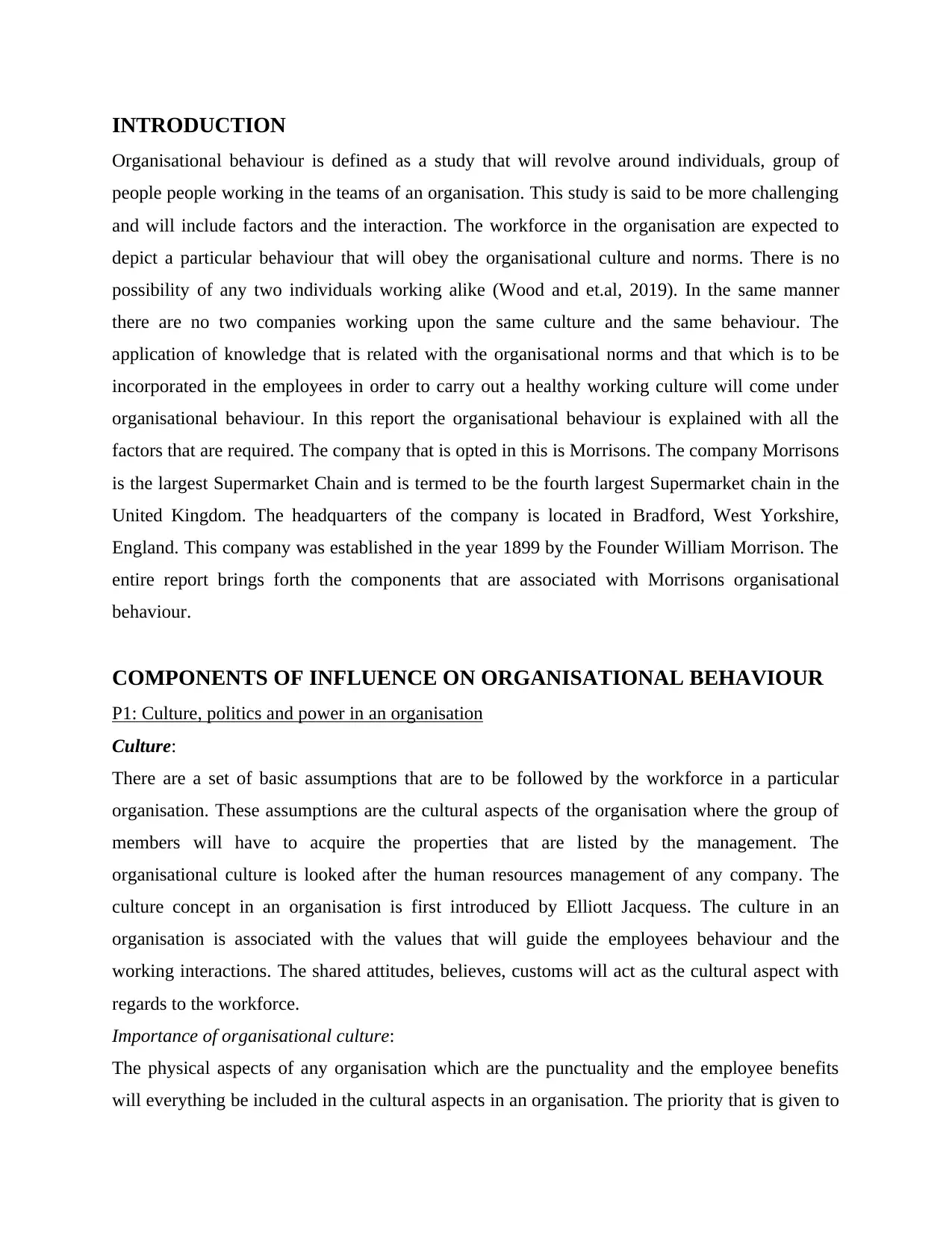
INTRODUCTION
Organisational behaviour is defined as a study that will revolve around individuals, group of
people people working in the teams of an organisation. This study is said to be more challenging
and will include factors and the interaction. The workforce in the organisation are expected to
depict a particular behaviour that will obey the organisational culture and norms. There is no
possibility of any two individuals working alike (Wood and et.al, 2019). In the same manner
there are no two companies working upon the same culture and the same behaviour. The
application of knowledge that is related with the organisational norms and that which is to be
incorporated in the employees in order to carry out a healthy working culture will come under
organisational behaviour. In this report the organisational behaviour is explained with all the
factors that are required. The company that is opted in this is Morrisons. The company Morrisons
is the largest Supermarket Chain and is termed to be the fourth largest Supermarket chain in the
United Kingdom. The headquarters of the company is located in Bradford, West Yorkshire,
England. This company was established in the year 1899 by the Founder William Morrison. The
entire report brings forth the components that are associated with Morrisons organisational
behaviour.
COMPONENTS OF INFLUENCE ON ORGANISATIONAL BEHAVIOUR
P1: Culture, politics and power in an organisation
Culture:
There are a set of basic assumptions that are to be followed by the workforce in a particular
organisation. These assumptions are the cultural aspects of the organisation where the group of
members will have to acquire the properties that are listed by the management. The
organisational culture is looked after the human resources management of any company. The
culture concept in an organisation is first introduced by Elliott Jacquess. The culture in an
organisation is associated with the values that will guide the employees behaviour and the
working interactions. The shared attitudes, believes, customs will act as the cultural aspect with
regards to the workforce.
Importance of organisational culture:
The physical aspects of any organisation which are the punctuality and the employee benefits
will everything be included in the cultural aspects in an organisation. The priority that is given to
Organisational behaviour is defined as a study that will revolve around individuals, group of
people people working in the teams of an organisation. This study is said to be more challenging
and will include factors and the interaction. The workforce in the organisation are expected to
depict a particular behaviour that will obey the organisational culture and norms. There is no
possibility of any two individuals working alike (Wood and et.al, 2019). In the same manner
there are no two companies working upon the same culture and the same behaviour. The
application of knowledge that is related with the organisational norms and that which is to be
incorporated in the employees in order to carry out a healthy working culture will come under
organisational behaviour. In this report the organisational behaviour is explained with all the
factors that are required. The company that is opted in this is Morrisons. The company Morrisons
is the largest Supermarket Chain and is termed to be the fourth largest Supermarket chain in the
United Kingdom. The headquarters of the company is located in Bradford, West Yorkshire,
England. This company was established in the year 1899 by the Founder William Morrison. The
entire report brings forth the components that are associated with Morrisons organisational
behaviour.
COMPONENTS OF INFLUENCE ON ORGANISATIONAL BEHAVIOUR
P1: Culture, politics and power in an organisation
Culture:
There are a set of basic assumptions that are to be followed by the workforce in a particular
organisation. These assumptions are the cultural aspects of the organisation where the group of
members will have to acquire the properties that are listed by the management. The
organisational culture is looked after the human resources management of any company. The
culture concept in an organisation is first introduced by Elliott Jacquess. The culture in an
organisation is associated with the values that will guide the employees behaviour and the
working interactions. The shared attitudes, believes, customs will act as the cultural aspect with
regards to the workforce.
Importance of organisational culture:
The physical aspects of any organisation which are the punctuality and the employee benefits
will everything be included in the cultural aspects in an organisation. The priority that is given to
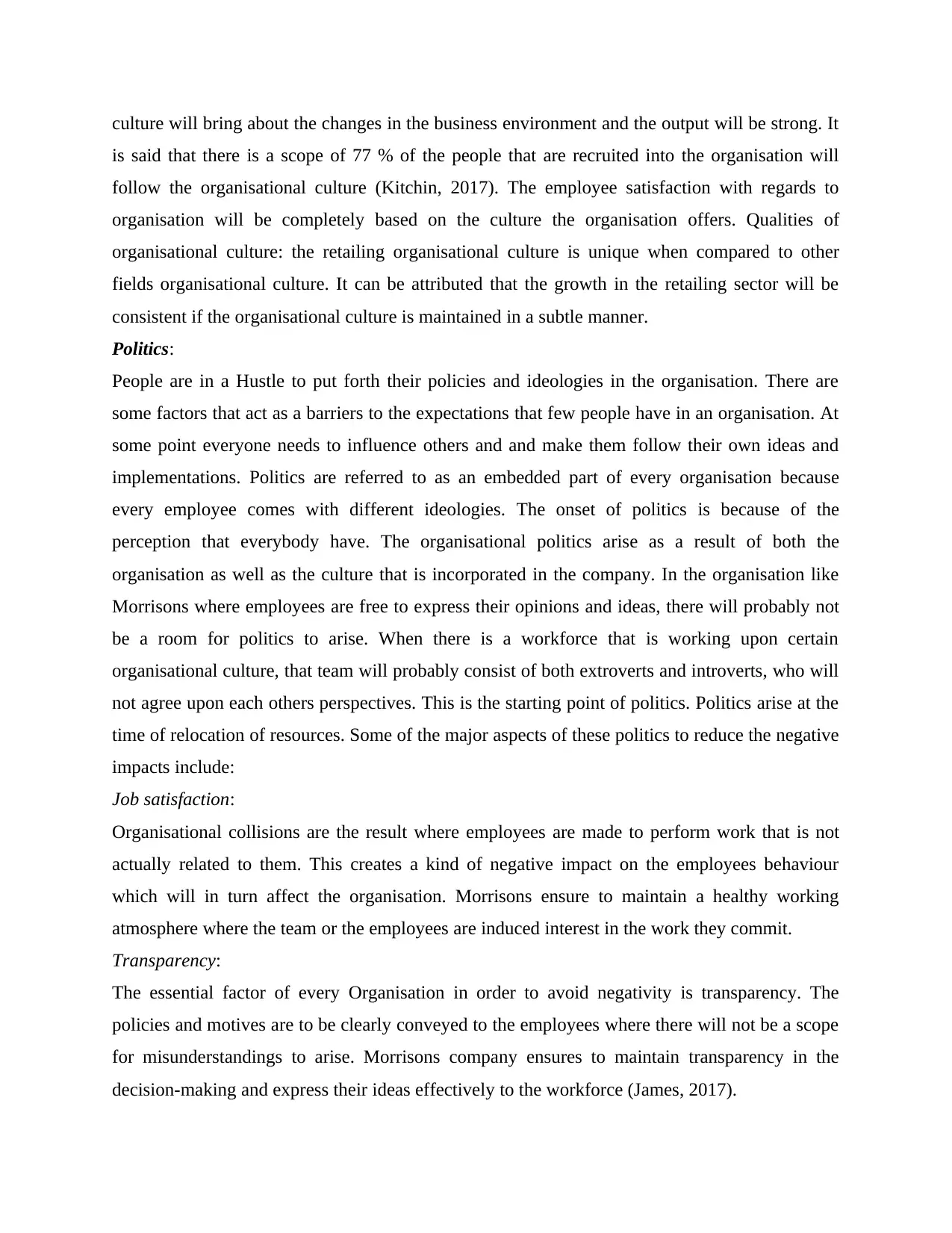
culture will bring about the changes in the business environment and the output will be strong. It
is said that there is a scope of 77 % of the people that are recruited into the organisation will
follow the organisational culture (Kitchin, 2017). The employee satisfaction with regards to
organisation will be completely based on the culture the organisation offers. Qualities of
organisational culture: the retailing organisational culture is unique when compared to other
fields organisational culture. It can be attributed that the growth in the retailing sector will be
consistent if the organisational culture is maintained in a subtle manner.
Politics:
People are in a Hustle to put forth their policies and ideologies in the organisation. There are
some factors that act as a barriers to the expectations that few people have in an organisation. At
some point everyone needs to influence others and and make them follow their own ideas and
implementations. Politics are referred to as an embedded part of every organisation because
every employee comes with different ideologies. The onset of politics is because of the
perception that everybody have. The organisational politics arise as a result of both the
organisation as well as the culture that is incorporated in the company. In the organisation like
Morrisons where employees are free to express their opinions and ideas, there will probably not
be a room for politics to arise. When there is a workforce that is working upon certain
organisational culture, that team will probably consist of both extroverts and introverts, who will
not agree upon each others perspectives. This is the starting point of politics. Politics arise at the
time of relocation of resources. Some of the major aspects of these politics to reduce the negative
impacts include:
Job satisfaction:
Organisational collisions are the result where employees are made to perform work that is not
actually related to them. This creates a kind of negative impact on the employees behaviour
which will in turn affect the organisation. Morrisons ensure to maintain a healthy working
atmosphere where the team or the employees are induced interest in the work they commit.
Transparency:
The essential factor of every Organisation in order to avoid negativity is transparency. The
policies and motives are to be clearly conveyed to the employees where there will not be a scope
for misunderstandings to arise. Morrisons company ensures to maintain transparency in the
decision-making and express their ideas effectively to the workforce (James, 2017).
is said that there is a scope of 77 % of the people that are recruited into the organisation will
follow the organisational culture (Kitchin, 2017). The employee satisfaction with regards to
organisation will be completely based on the culture the organisation offers. Qualities of
organisational culture: the retailing organisational culture is unique when compared to other
fields organisational culture. It can be attributed that the growth in the retailing sector will be
consistent if the organisational culture is maintained in a subtle manner.
Politics:
People are in a Hustle to put forth their policies and ideologies in the organisation. There are
some factors that act as a barriers to the expectations that few people have in an organisation. At
some point everyone needs to influence others and and make them follow their own ideas and
implementations. Politics are referred to as an embedded part of every organisation because
every employee comes with different ideologies. The onset of politics is because of the
perception that everybody have. The organisational politics arise as a result of both the
organisation as well as the culture that is incorporated in the company. In the organisation like
Morrisons where employees are free to express their opinions and ideas, there will probably not
be a room for politics to arise. When there is a workforce that is working upon certain
organisational culture, that team will probably consist of both extroverts and introverts, who will
not agree upon each others perspectives. This is the starting point of politics. Politics arise at the
time of relocation of resources. Some of the major aspects of these politics to reduce the negative
impacts include:
Job satisfaction:
Organisational collisions are the result where employees are made to perform work that is not
actually related to them. This creates a kind of negative impact on the employees behaviour
which will in turn affect the organisation. Morrisons ensure to maintain a healthy working
atmosphere where the team or the employees are induced interest in the work they commit.
Transparency:
The essential factor of every Organisation in order to avoid negativity is transparency. The
policies and motives are to be clearly conveyed to the employees where there will not be a scope
for misunderstandings to arise. Morrisons company ensures to maintain transparency in the
decision-making and express their ideas effectively to the workforce (James, 2017).
Secure Best Marks with AI Grader
Need help grading? Try our AI Grader for instant feedback on your assignments.
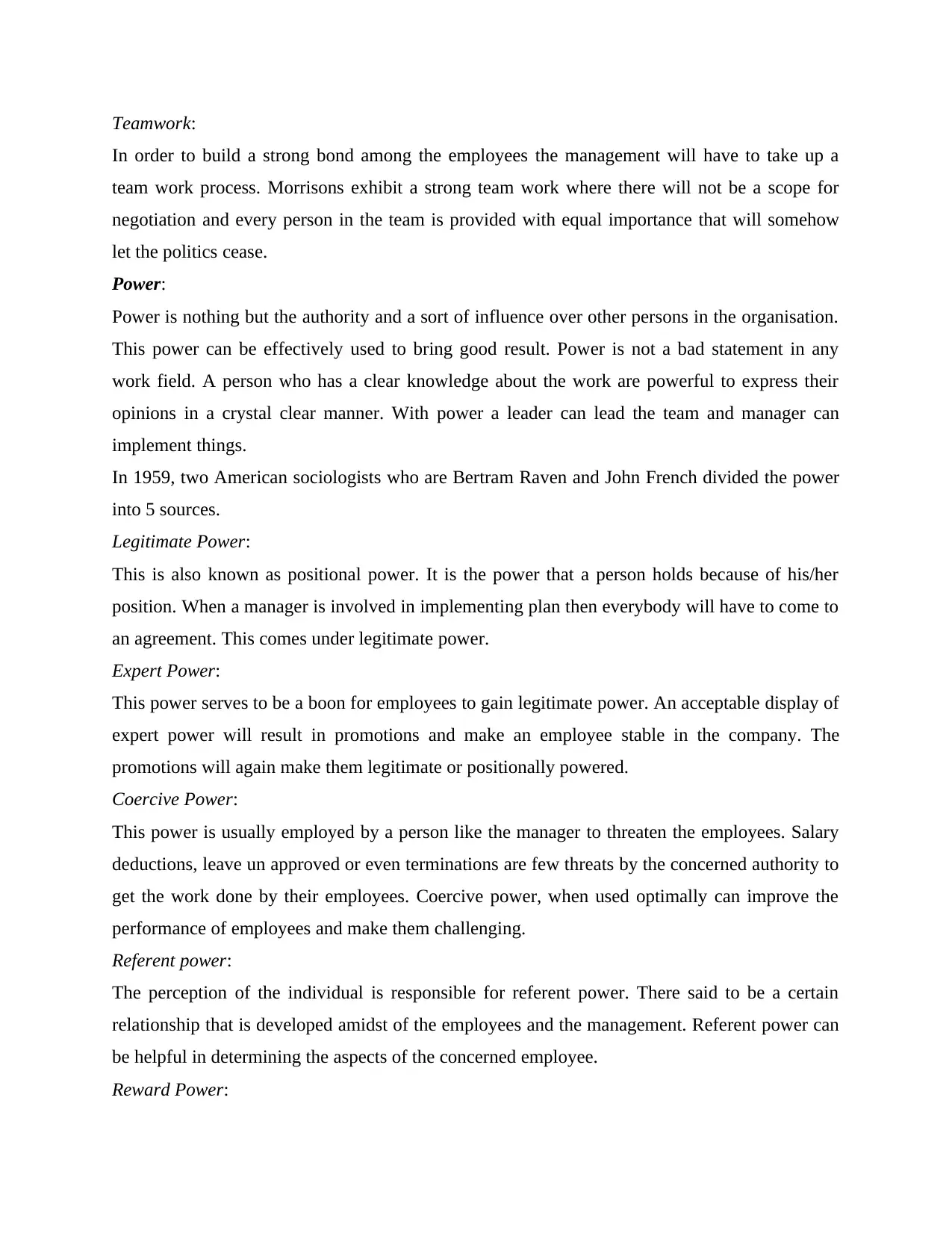
Teamwork:
In order to build a strong bond among the employees the management will have to take up a
team work process. Morrisons exhibit a strong team work where there will not be a scope for
negotiation and every person in the team is provided with equal importance that will somehow
let the politics cease.
Power:
Power is nothing but the authority and a sort of influence over other persons in the organisation.
This power can be effectively used to bring good result. Power is not a bad statement in any
work field. A person who has a clear knowledge about the work are powerful to express their
opinions in a crystal clear manner. With power a leader can lead the team and manager can
implement things.
In 1959, two American sociologists who are Bertram Raven and John French divided the power
into 5 sources.
Legitimate Power:
This is also known as positional power. It is the power that a person holds because of his/her
position. When a manager is involved in implementing plan then everybody will have to come to
an agreement. This comes under legitimate power.
Expert Power:
This power serves to be a boon for employees to gain legitimate power. An acceptable display of
expert power will result in promotions and make an employee stable in the company. The
promotions will again make them legitimate or positionally powered.
Coercive Power:
This power is usually employed by a person like the manager to threaten the employees. Salary
deductions, leave un approved or even terminations are few threats by the concerned authority to
get the work done by their employees. Coercive power, when used optimally can improve the
performance of employees and make them challenging.
Referent power:
The perception of the individual is responsible for referent power. There said to be a certain
relationship that is developed amidst of the employees and the management. Referent power can
be helpful in determining the aspects of the concerned employee.
Reward Power:
In order to build a strong bond among the employees the management will have to take up a
team work process. Morrisons exhibit a strong team work where there will not be a scope for
negotiation and every person in the team is provided with equal importance that will somehow
let the politics cease.
Power:
Power is nothing but the authority and a sort of influence over other persons in the organisation.
This power can be effectively used to bring good result. Power is not a bad statement in any
work field. A person who has a clear knowledge about the work are powerful to express their
opinions in a crystal clear manner. With power a leader can lead the team and manager can
implement things.
In 1959, two American sociologists who are Bertram Raven and John French divided the power
into 5 sources.
Legitimate Power:
This is also known as positional power. It is the power that a person holds because of his/her
position. When a manager is involved in implementing plan then everybody will have to come to
an agreement. This comes under legitimate power.
Expert Power:
This power serves to be a boon for employees to gain legitimate power. An acceptable display of
expert power will result in promotions and make an employee stable in the company. The
promotions will again make them legitimate or positionally powered.
Coercive Power:
This power is usually employed by a person like the manager to threaten the employees. Salary
deductions, leave un approved or even terminations are few threats by the concerned authority to
get the work done by their employees. Coercive power, when used optimally can improve the
performance of employees and make them challenging.
Referent power:
The perception of the individual is responsible for referent power. There said to be a certain
relationship that is developed amidst of the employees and the management. Referent power can
be helpful in determining the aspects of the concerned employee.
Reward Power:
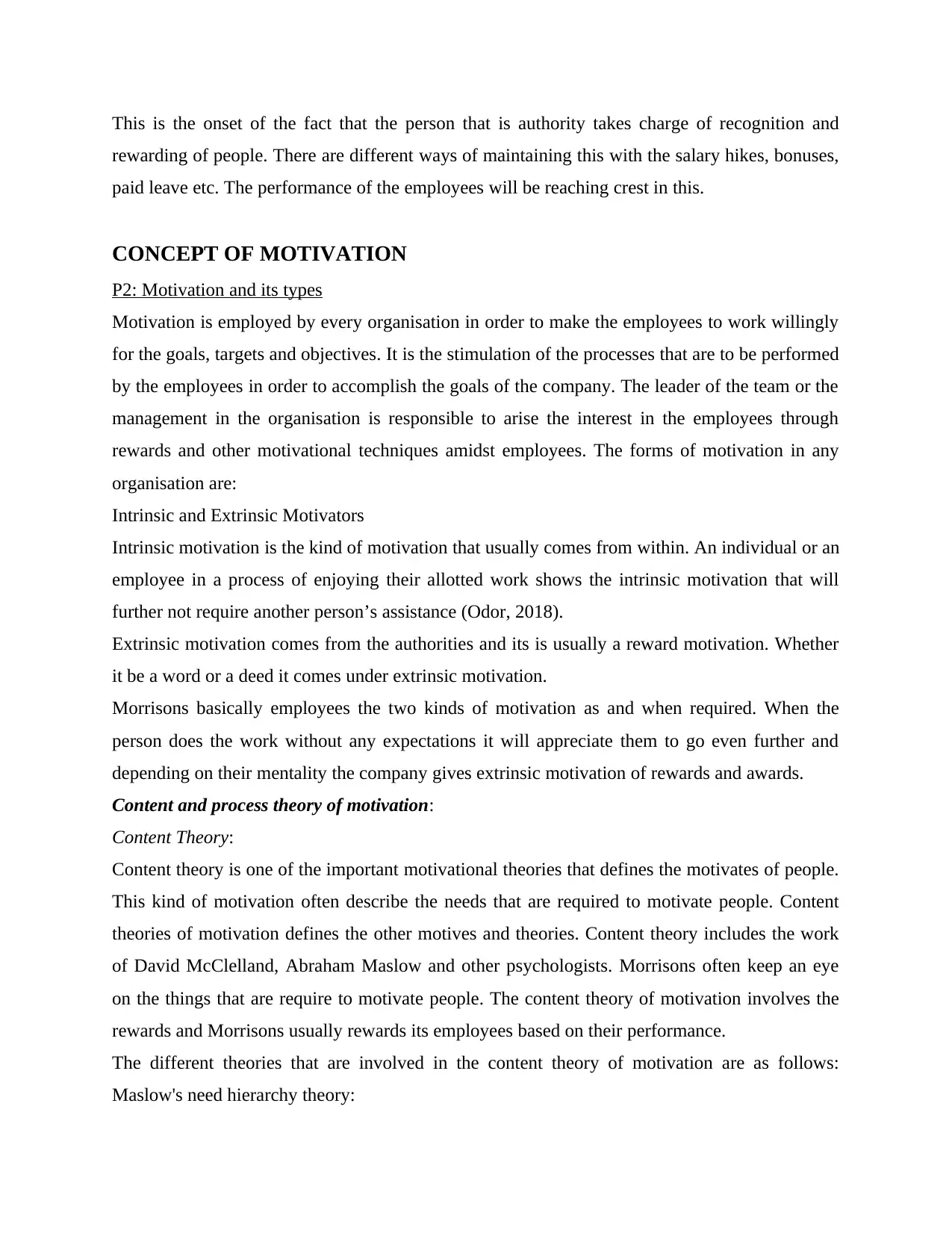
This is the onset of the fact that the person that is authority takes charge of recognition and
rewarding of people. There are different ways of maintaining this with the salary hikes, bonuses,
paid leave etc. The performance of the employees will be reaching crest in this.
CONCEPT OF MOTIVATION
P2: Motivation and its types
Motivation is employed by every organisation in order to make the employees to work willingly
for the goals, targets and objectives. It is the stimulation of the processes that are to be performed
by the employees in order to accomplish the goals of the company. The leader of the team or the
management in the organisation is responsible to arise the interest in the employees through
rewards and other motivational techniques amidst employees. The forms of motivation in any
organisation are:
Intrinsic and Extrinsic Motivators
Intrinsic motivation is the kind of motivation that usually comes from within. An individual or an
employee in a process of enjoying their allotted work shows the intrinsic motivation that will
further not require another person’s assistance (Odor, 2018).
Extrinsic motivation comes from the authorities and its is usually a reward motivation. Whether
it be a word or a deed it comes under extrinsic motivation.
Morrisons basically employees the two kinds of motivation as and when required. When the
person does the work without any expectations it will appreciate them to go even further and
depending on their mentality the company gives extrinsic motivation of rewards and awards.
Content and process theory of motivation:
Content Theory:
Content theory is one of the important motivational theories that defines the motivates of people.
This kind of motivation often describe the needs that are required to motivate people. Content
theories of motivation defines the other motives and theories. Content theory includes the work
of David McClelland, Abraham Maslow and other psychologists. Morrisons often keep an eye
on the things that are require to motivate people. The content theory of motivation involves the
rewards and Morrisons usually rewards its employees based on their performance.
The different theories that are involved in the content theory of motivation are as follows:
Maslow's need hierarchy theory:
rewarding of people. There are different ways of maintaining this with the salary hikes, bonuses,
paid leave etc. The performance of the employees will be reaching crest in this.
CONCEPT OF MOTIVATION
P2: Motivation and its types
Motivation is employed by every organisation in order to make the employees to work willingly
for the goals, targets and objectives. It is the stimulation of the processes that are to be performed
by the employees in order to accomplish the goals of the company. The leader of the team or the
management in the organisation is responsible to arise the interest in the employees through
rewards and other motivational techniques amidst employees. The forms of motivation in any
organisation are:
Intrinsic and Extrinsic Motivators
Intrinsic motivation is the kind of motivation that usually comes from within. An individual or an
employee in a process of enjoying their allotted work shows the intrinsic motivation that will
further not require another person’s assistance (Odor, 2018).
Extrinsic motivation comes from the authorities and its is usually a reward motivation. Whether
it be a word or a deed it comes under extrinsic motivation.
Morrisons basically employees the two kinds of motivation as and when required. When the
person does the work without any expectations it will appreciate them to go even further and
depending on their mentality the company gives extrinsic motivation of rewards and awards.
Content and process theory of motivation:
Content Theory:
Content theory is one of the important motivational theories that defines the motivates of people.
This kind of motivation often describe the needs that are required to motivate people. Content
theories of motivation defines the other motives and theories. Content theory includes the work
of David McClelland, Abraham Maslow and other psychologists. Morrisons often keep an eye
on the things that are require to motivate people. The content theory of motivation involves the
rewards and Morrisons usually rewards its employees based on their performance.
The different theories that are involved in the content theory of motivation are as follows:
Maslow's need hierarchy theory:
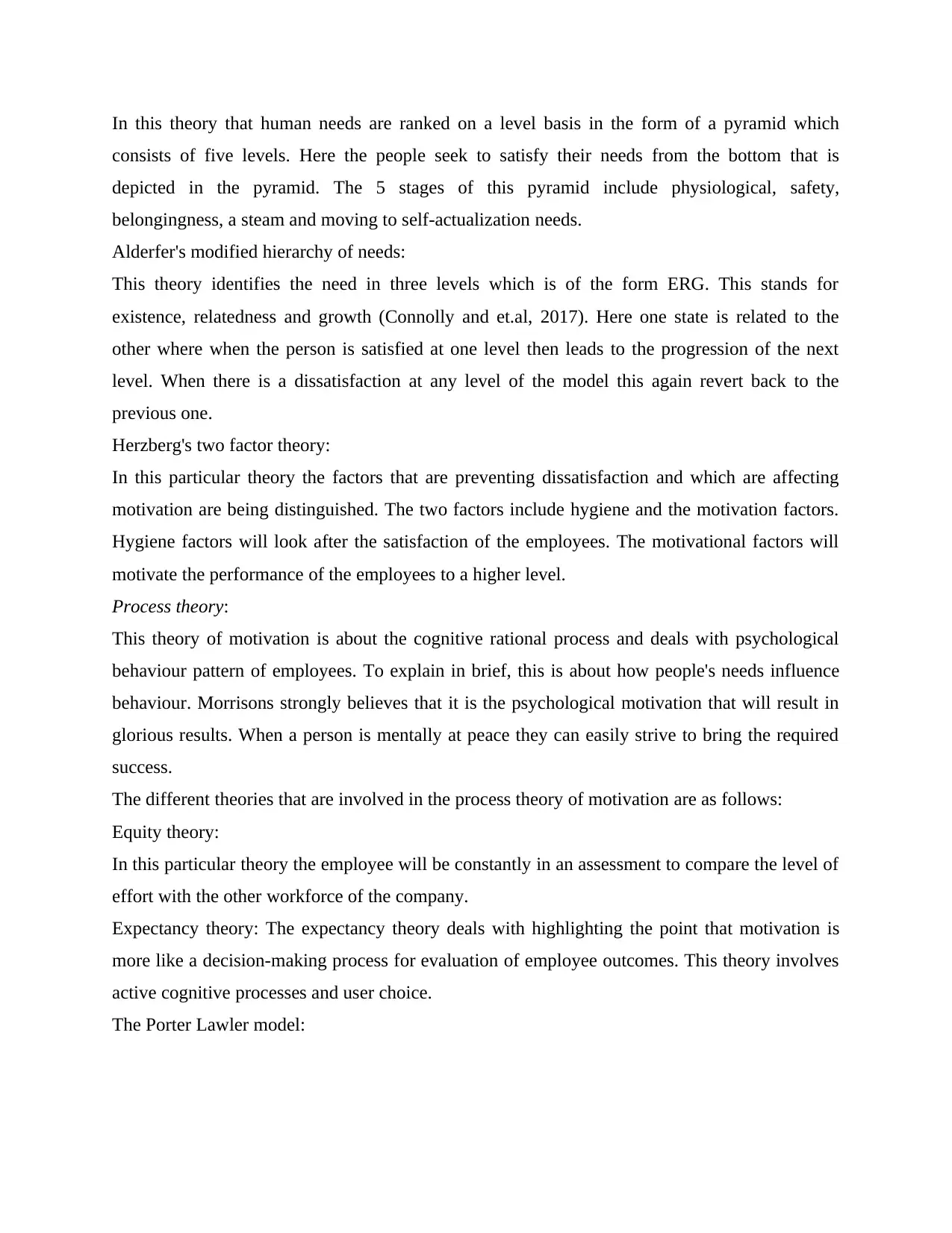
In this theory that human needs are ranked on a level basis in the form of a pyramid which
consists of five levels. Here the people seek to satisfy their needs from the bottom that is
depicted in the pyramid. The 5 stages of this pyramid include physiological, safety,
belongingness, a steam and moving to self-actualization needs.
Alderfer's modified hierarchy of needs:
This theory identifies the need in three levels which is of the form ERG. This stands for
existence, relatedness and growth (Connolly and et.al, 2017). Here one state is related to the
other where when the person is satisfied at one level then leads to the progression of the next
level. When there is a dissatisfaction at any level of the model this again revert back to the
previous one.
Herzberg's two factor theory:
In this particular theory the factors that are preventing dissatisfaction and which are affecting
motivation are being distinguished. The two factors include hygiene and the motivation factors.
Hygiene factors will look after the satisfaction of the employees. The motivational factors will
motivate the performance of the employees to a higher level.
Process theory:
This theory of motivation is about the cognitive rational process and deals with psychological
behaviour pattern of employees. To explain in brief, this is about how people's needs influence
behaviour. Morrisons strongly believes that it is the psychological motivation that will result in
glorious results. When a person is mentally at peace they can easily strive to bring the required
success.
The different theories that are involved in the process theory of motivation are as follows:
Equity theory:
In this particular theory the employee will be constantly in an assessment to compare the level of
effort with the other workforce of the company.
Expectancy theory: The expectancy theory deals with highlighting the point that motivation is
more like a decision-making process for evaluation of employee outcomes. This theory involves
active cognitive processes and user choice.
The Porter Lawler model:
consists of five levels. Here the people seek to satisfy their needs from the bottom that is
depicted in the pyramid. The 5 stages of this pyramid include physiological, safety,
belongingness, a steam and moving to self-actualization needs.
Alderfer's modified hierarchy of needs:
This theory identifies the need in three levels which is of the form ERG. This stands for
existence, relatedness and growth (Connolly and et.al, 2017). Here one state is related to the
other where when the person is satisfied at one level then leads to the progression of the next
level. When there is a dissatisfaction at any level of the model this again revert back to the
previous one.
Herzberg's two factor theory:
In this particular theory the factors that are preventing dissatisfaction and which are affecting
motivation are being distinguished. The two factors include hygiene and the motivation factors.
Hygiene factors will look after the satisfaction of the employees. The motivational factors will
motivate the performance of the employees to a higher level.
Process theory:
This theory of motivation is about the cognitive rational process and deals with psychological
behaviour pattern of employees. To explain in brief, this is about how people's needs influence
behaviour. Morrisons strongly believes that it is the psychological motivation that will result in
glorious results. When a person is mentally at peace they can easily strive to bring the required
success.
The different theories that are involved in the process theory of motivation are as follows:
Equity theory:
In this particular theory the employee will be constantly in an assessment to compare the level of
effort with the other workforce of the company.
Expectancy theory: The expectancy theory deals with highlighting the point that motivation is
more like a decision-making process for evaluation of employee outcomes. This theory involves
active cognitive processes and user choice.
The Porter Lawler model:
Paraphrase This Document
Need a fresh take? Get an instant paraphrase of this document with our AI Paraphraser
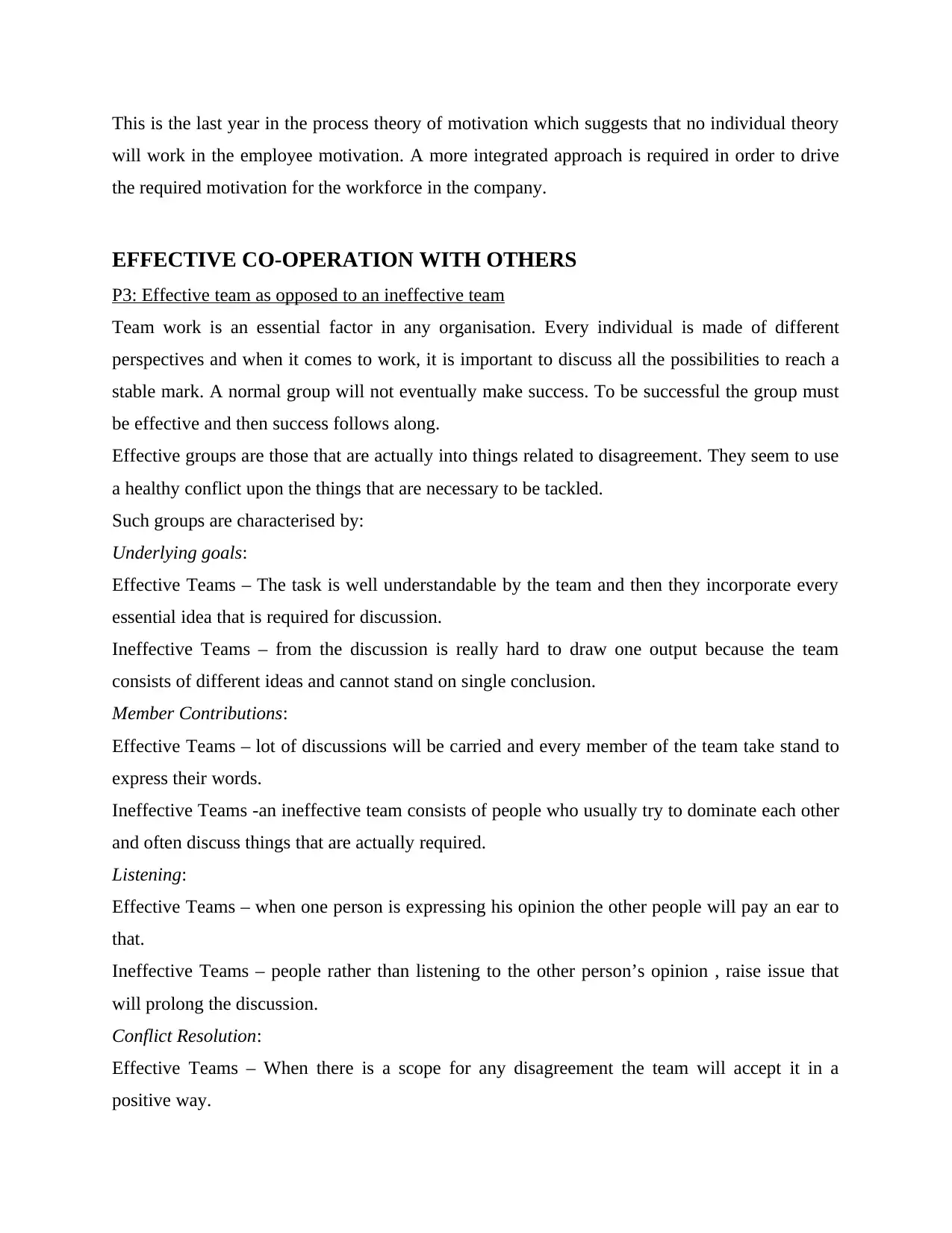
This is the last year in the process theory of motivation which suggests that no individual theory
will work in the employee motivation. A more integrated approach is required in order to drive
the required motivation for the workforce in the company.
EFFECTIVE CO-OPERATION WITH OTHERS
P3: Effective team as opposed to an ineffective team
Team work is an essential factor in any organisation. Every individual is made of different
perspectives and when it comes to work, it is important to discuss all the possibilities to reach a
stable mark. A normal group will not eventually make success. To be successful the group must
be effective and then success follows along.
Effective groups are those that are actually into things related to disagreement. They seem to use
a healthy conflict upon the things that are necessary to be tackled.
Such groups are characterised by:
Underlying goals:
Effective Teams – The task is well understandable by the team and then they incorporate every
essential idea that is required for discussion.
Ineffective Teams – from the discussion is really hard to draw one output because the team
consists of different ideas and cannot stand on single conclusion.
Member Contributions:
Effective Teams – lot of discussions will be carried and every member of the team take stand to
express their words.
Ineffective Teams -an ineffective team consists of people who usually try to dominate each other
and often discuss things that are actually required.
Listening:
Effective Teams – when one person is expressing his opinion the other people will pay an ear to
that.
Ineffective Teams – people rather than listening to the other person’s opinion , raise issue that
will prolong the discussion.
Conflict Resolution:
Effective Teams – When there is a scope for any disagreement the team will accept it in a
positive way.
will work in the employee motivation. A more integrated approach is required in order to drive
the required motivation for the workforce in the company.
EFFECTIVE CO-OPERATION WITH OTHERS
P3: Effective team as opposed to an ineffective team
Team work is an essential factor in any organisation. Every individual is made of different
perspectives and when it comes to work, it is important to discuss all the possibilities to reach a
stable mark. A normal group will not eventually make success. To be successful the group must
be effective and then success follows along.
Effective groups are those that are actually into things related to disagreement. They seem to use
a healthy conflict upon the things that are necessary to be tackled.
Such groups are characterised by:
Underlying goals:
Effective Teams – The task is well understandable by the team and then they incorporate every
essential idea that is required for discussion.
Ineffective Teams – from the discussion is really hard to draw one output because the team
consists of different ideas and cannot stand on single conclusion.
Member Contributions:
Effective Teams – lot of discussions will be carried and every member of the team take stand to
express their words.
Ineffective Teams -an ineffective team consists of people who usually try to dominate each other
and often discuss things that are actually required.
Listening:
Effective Teams – when one person is expressing his opinion the other people will pay an ear to
that.
Ineffective Teams – people rather than listening to the other person’s opinion , raise issue that
will prolong the discussion.
Conflict Resolution:
Effective Teams – When there is a scope for any disagreement the team will accept it in a
positive way.
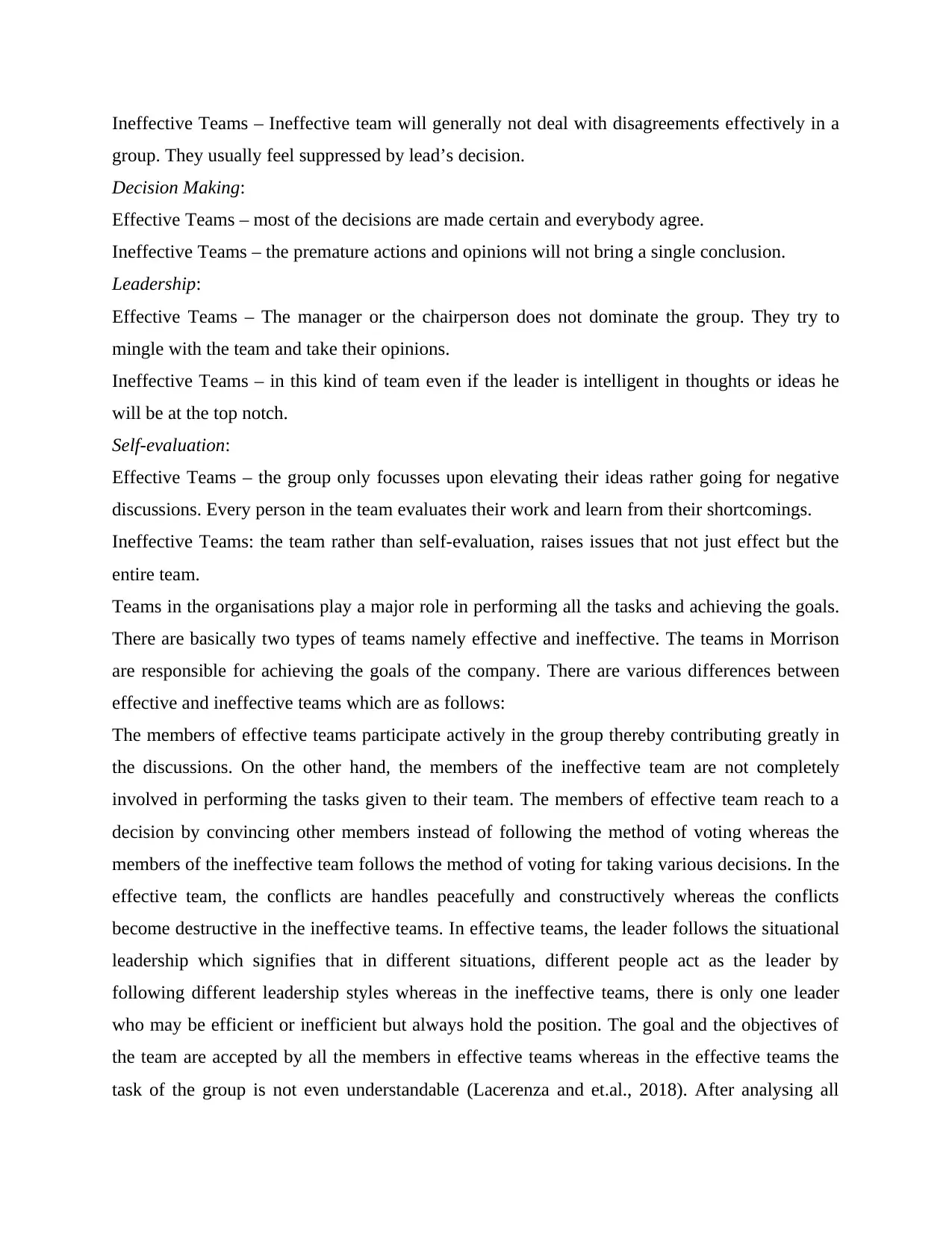
Ineffective Teams – Ineffective team will generally not deal with disagreements effectively in a
group. They usually feel suppressed by lead’s decision.
Decision Making:
Effective Teams – most of the decisions are made certain and everybody agree.
Ineffective Teams – the premature actions and opinions will not bring a single conclusion.
Leadership:
Effective Teams – The manager or the chairperson does not dominate the group. They try to
mingle with the team and take their opinions.
Ineffective Teams – in this kind of team even if the leader is intelligent in thoughts or ideas he
will be at the top notch.
Self-evaluation:
Effective Teams – the group only focusses upon elevating their ideas rather going for negative
discussions. Every person in the team evaluates their work and learn from their shortcomings.
Ineffective Teams: the team rather than self-evaluation, raises issues that not just effect but the
entire team.
Teams in the organisations play a major role in performing all the tasks and achieving the goals.
There are basically two types of teams namely effective and ineffective. The teams in Morrison
are responsible for achieving the goals of the company. There are various differences between
effective and ineffective teams which are as follows:
The members of effective teams participate actively in the group thereby contributing greatly in
the discussions. On the other hand, the members of the ineffective team are not completely
involved in performing the tasks given to their team. The members of effective team reach to a
decision by convincing other members instead of following the method of voting whereas the
members of the ineffective team follows the method of voting for taking various decisions. In the
effective team, the conflicts are handles peacefully and constructively whereas the conflicts
become destructive in the ineffective teams. In effective teams, the leader follows the situational
leadership which signifies that in different situations, different people act as the leader by
following different leadership styles whereas in the ineffective teams, there is only one leader
who may be efficient or inefficient but always hold the position. The goal and the objectives of
the team are accepted by all the members in effective teams whereas in the effective teams the
task of the group is not even understandable (Lacerenza and et.al., 2018). After analysing all
group. They usually feel suppressed by lead’s decision.
Decision Making:
Effective Teams – most of the decisions are made certain and everybody agree.
Ineffective Teams – the premature actions and opinions will not bring a single conclusion.
Leadership:
Effective Teams – The manager or the chairperson does not dominate the group. They try to
mingle with the team and take their opinions.
Ineffective Teams – in this kind of team even if the leader is intelligent in thoughts or ideas he
will be at the top notch.
Self-evaluation:
Effective Teams – the group only focusses upon elevating their ideas rather going for negative
discussions. Every person in the team evaluates their work and learn from their shortcomings.
Ineffective Teams: the team rather than self-evaluation, raises issues that not just effect but the
entire team.
Teams in the organisations play a major role in performing all the tasks and achieving the goals.
There are basically two types of teams namely effective and ineffective. The teams in Morrison
are responsible for achieving the goals of the company. There are various differences between
effective and ineffective teams which are as follows:
The members of effective teams participate actively in the group thereby contributing greatly in
the discussions. On the other hand, the members of the ineffective team are not completely
involved in performing the tasks given to their team. The members of effective team reach to a
decision by convincing other members instead of following the method of voting whereas the
members of the ineffective team follows the method of voting for taking various decisions. In the
effective team, the conflicts are handles peacefully and constructively whereas the conflicts
become destructive in the ineffective teams. In effective teams, the leader follows the situational
leadership which signifies that in different situations, different people act as the leader by
following different leadership styles whereas in the ineffective teams, there is only one leader
who may be efficient or inefficient but always hold the position. The goal and the objectives of
the team are accepted by all the members in effective teams whereas in the effective teams the
task of the group is not even understandable (Lacerenza and et.al., 2018). After analysing all

these characteristics and the differences in the effective and ineffective teams, it can be said that
Morrison consist of both ineffective and effective teams which contributes at their own level to
achieve the organisational objectives. The company strives hard to make its ineffective teams
effective so that they can contribute greatly towards the success and progress of the company.
There are various theories and models for effective team development. Morrison use the
Tuckman’s model in which the teams go through 5 stages for its development towards effective
teams. Every stage contributes effectively towards the effective team development:
The first stage in the model is the forming stage in which the team and team members are
introduced to each other in polite and pleasant ways (Chen and Agrawal, 2018). In this stage, the
discussion is about the skills of the members, goals of the team, timeline, ground rules,
individual roles etc. After this, the storming stage comes in which the members come to know
about the real personalities of each other which may also lead to clashes. The third stage is the
norming stage in which the members of team appreciate each other’s strengths and the team
starts to settle. The next stage is the performing stage in which the members become motivated,
confident and familiar with the task and strives hard to achieve the goals (Pfutzenreuter, de Lima
and Frega, 2020). The last stage is the adjourning stage in which the team disbands and the goals
are achieved. This is how; effective teams are developed in Morrison.
CONCEPTS AND PHILOSOPHIES OF ORGANISATIONAL BEHAVIOUR
P4: Concepts and philosophies of organisational behaviour
Organisational philosophy in a company deals with the purpose of employees work and offer the
can distinctively do their stipulated task. If the organisations will have to run successfully the
employees will have to maintain a consistency which is regarded as a core attribute for the
decision making in the organisation. This factor of an organisation can either be a core value or a
set of principle that the organisation follows. This feature can distinguish the company from over
brand new companies. Philosophies are said to be embedded as one of the essential core values
in the organisation. The employees believes in the organisation distinguish their behaviour from
the other workforce (Gopalan and et.al, 2017). Every other factor that the organisation adopted
can be replaced but the organisational philosophy is the strength of the organisation and it will
have to be emphasized rather than being replaced. In order to organise a particular management
Morrison consist of both ineffective and effective teams which contributes at their own level to
achieve the organisational objectives. The company strives hard to make its ineffective teams
effective so that they can contribute greatly towards the success and progress of the company.
There are various theories and models for effective team development. Morrison use the
Tuckman’s model in which the teams go through 5 stages for its development towards effective
teams. Every stage contributes effectively towards the effective team development:
The first stage in the model is the forming stage in which the team and team members are
introduced to each other in polite and pleasant ways (Chen and Agrawal, 2018). In this stage, the
discussion is about the skills of the members, goals of the team, timeline, ground rules,
individual roles etc. After this, the storming stage comes in which the members come to know
about the real personalities of each other which may also lead to clashes. The third stage is the
norming stage in which the members of team appreciate each other’s strengths and the team
starts to settle. The next stage is the performing stage in which the members become motivated,
confident and familiar with the task and strives hard to achieve the goals (Pfutzenreuter, de Lima
and Frega, 2020). The last stage is the adjourning stage in which the team disbands and the goals
are achieved. This is how; effective teams are developed in Morrison.
CONCEPTS AND PHILOSOPHIES OF ORGANISATIONAL BEHAVIOUR
P4: Concepts and philosophies of organisational behaviour
Organisational philosophy in a company deals with the purpose of employees work and offer the
can distinctively do their stipulated task. If the organisations will have to run successfully the
employees will have to maintain a consistency which is regarded as a core attribute for the
decision making in the organisation. This factor of an organisation can either be a core value or a
set of principle that the organisation follows. This feature can distinguish the company from over
brand new companies. Philosophies are said to be embedded as one of the essential core values
in the organisation. The employees believes in the organisation distinguish their behaviour from
the other workforce (Gopalan and et.al, 2017). Every other factor that the organisation adopted
can be replaced but the organisational philosophy is the strength of the organisation and it will
have to be emphasized rather than being replaced. In order to organise a particular management
Secure Best Marks with AI Grader
Need help grading? Try our AI Grader for instant feedback on your assignments.
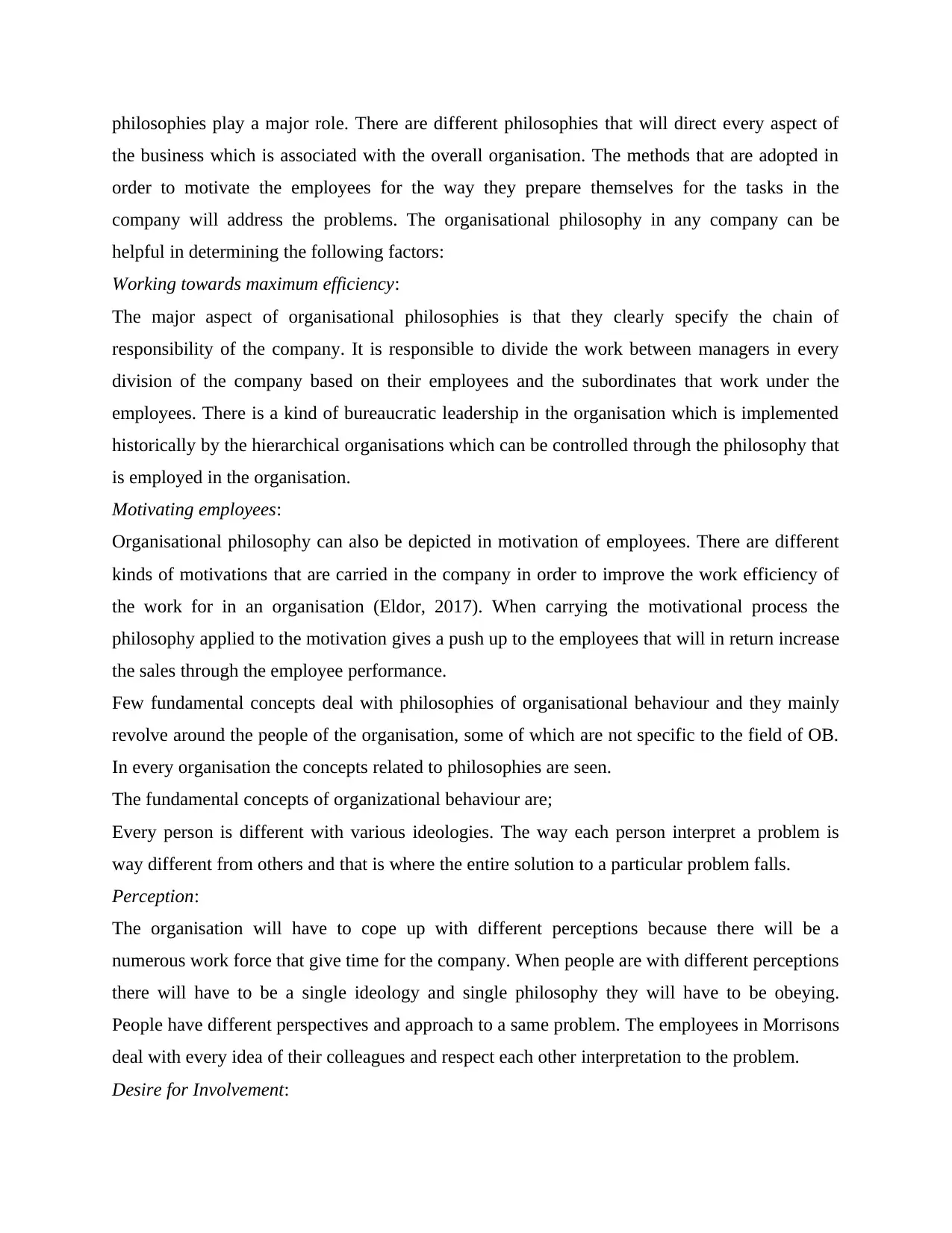
philosophies play a major role. There are different philosophies that will direct every aspect of
the business which is associated with the overall organisation. The methods that are adopted in
order to motivate the employees for the way they prepare themselves for the tasks in the
company will address the problems. The organisational philosophy in any company can be
helpful in determining the following factors:
Working towards maximum efficiency:
The major aspect of organisational philosophies is that they clearly specify the chain of
responsibility of the company. It is responsible to divide the work between managers in every
division of the company based on their employees and the subordinates that work under the
employees. There is a kind of bureaucratic leadership in the organisation which is implemented
historically by the hierarchical organisations which can be controlled through the philosophy that
is employed in the organisation.
Motivating employees:
Organisational philosophy can also be depicted in motivation of employees. There are different
kinds of motivations that are carried in the company in order to improve the work efficiency of
the work for in an organisation (Eldor, 2017). When carrying the motivational process the
philosophy applied to the motivation gives a push up to the employees that will in return increase
the sales through the employee performance.
Few fundamental concepts deal with philosophies of organisational behaviour and they mainly
revolve around the people of the organisation, some of which are not specific to the field of OB.
In every organisation the concepts related to philosophies are seen.
The fundamental concepts of organizational behaviour are;
Every person is different with various ideologies. The way each person interpret a problem is
way different from others and that is where the entire solution to a particular problem falls.
Perception:
The organisation will have to cope up with different perceptions because there will be a
numerous work force that give time for the company. When people are with different perceptions
there will have to be a single ideology and single philosophy they will have to be obeying.
People have different perspectives and approach to a same problem. The employees in Morrisons
deal with every idea of their colleagues and respect each other interpretation to the problem.
Desire for Involvement:
the business which is associated with the overall organisation. The methods that are adopted in
order to motivate the employees for the way they prepare themselves for the tasks in the
company will address the problems. The organisational philosophy in any company can be
helpful in determining the following factors:
Working towards maximum efficiency:
The major aspect of organisational philosophies is that they clearly specify the chain of
responsibility of the company. It is responsible to divide the work between managers in every
division of the company based on their employees and the subordinates that work under the
employees. There is a kind of bureaucratic leadership in the organisation which is implemented
historically by the hierarchical organisations which can be controlled through the philosophy that
is employed in the organisation.
Motivating employees:
Organisational philosophy can also be depicted in motivation of employees. There are different
kinds of motivations that are carried in the company in order to improve the work efficiency of
the work for in an organisation (Eldor, 2017). When carrying the motivational process the
philosophy applied to the motivation gives a push up to the employees that will in return increase
the sales through the employee performance.
Few fundamental concepts deal with philosophies of organisational behaviour and they mainly
revolve around the people of the organisation, some of which are not specific to the field of OB.
In every organisation the concepts related to philosophies are seen.
The fundamental concepts of organizational behaviour are;
Every person is different with various ideologies. The way each person interpret a problem is
way different from others and that is where the entire solution to a particular problem falls.
Perception:
The organisation will have to cope up with different perceptions because there will be a
numerous work force that give time for the company. When people are with different perceptions
there will have to be a single ideology and single philosophy they will have to be obeying.
People have different perspectives and approach to a same problem. The employees in Morrisons
deal with every idea of their colleagues and respect each other interpretation to the problem.
Desire for Involvement:
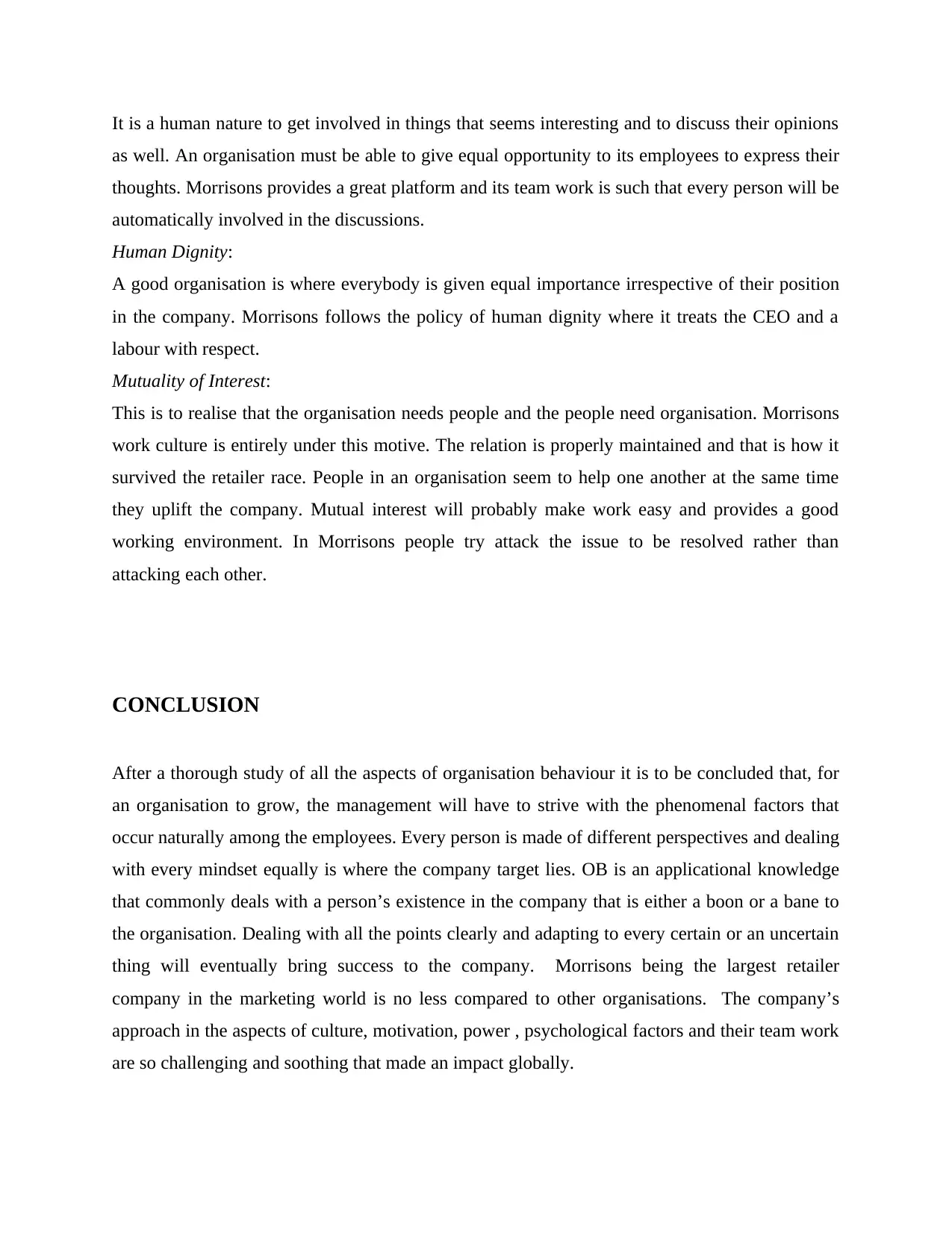
It is a human nature to get involved in things that seems interesting and to discuss their opinions
as well. An organisation must be able to give equal opportunity to its employees to express their
thoughts. Morrisons provides a great platform and its team work is such that every person will be
automatically involved in the discussions.
Human Dignity:
A good organisation is where everybody is given equal importance irrespective of their position
in the company. Morrisons follows the policy of human dignity where it treats the CEO and a
labour with respect.
Mutuality of Interest:
This is to realise that the organisation needs people and the people need organisation. Morrisons
work culture is entirely under this motive. The relation is properly maintained and that is how it
survived the retailer race. People in an organisation seem to help one another at the same time
they uplift the company. Mutual interest will probably make work easy and provides a good
working environment. In Morrisons people try attack the issue to be resolved rather than
attacking each other.
CONCLUSION
After a thorough study of all the aspects of organisation behaviour it is to be concluded that, for
an organisation to grow, the management will have to strive with the phenomenal factors that
occur naturally among the employees. Every person is made of different perspectives and dealing
with every mindset equally is where the company target lies. OB is an applicational knowledge
that commonly deals with a person’s existence in the company that is either a boon or a bane to
the organisation. Dealing with all the points clearly and adapting to every certain or an uncertain
thing will eventually bring success to the company. Morrisons being the largest retailer
company in the marketing world is no less compared to other organisations. The company’s
approach in the aspects of culture, motivation, power , psychological factors and their team work
are so challenging and soothing that made an impact globally.
as well. An organisation must be able to give equal opportunity to its employees to express their
thoughts. Morrisons provides a great platform and its team work is such that every person will be
automatically involved in the discussions.
Human Dignity:
A good organisation is where everybody is given equal importance irrespective of their position
in the company. Morrisons follows the policy of human dignity where it treats the CEO and a
labour with respect.
Mutuality of Interest:
This is to realise that the organisation needs people and the people need organisation. Morrisons
work culture is entirely under this motive. The relation is properly maintained and that is how it
survived the retailer race. People in an organisation seem to help one another at the same time
they uplift the company. Mutual interest will probably make work easy and provides a good
working environment. In Morrisons people try attack the issue to be resolved rather than
attacking each other.
CONCLUSION
After a thorough study of all the aspects of organisation behaviour it is to be concluded that, for
an organisation to grow, the management will have to strive with the phenomenal factors that
occur naturally among the employees. Every person is made of different perspectives and dealing
with every mindset equally is where the company target lies. OB is an applicational knowledge
that commonly deals with a person’s existence in the company that is either a boon or a bane to
the organisation. Dealing with all the points clearly and adapting to every certain or an uncertain
thing will eventually bring success to the company. Morrisons being the largest retailer
company in the marketing world is no less compared to other organisations. The company’s
approach in the aspects of culture, motivation, power , psychological factors and their team work
are so challenging and soothing that made an impact globally.

REFERENCES
Books and journals
Wood and et.al, 2019. Organisational behaviour: Core concepts and applications. John Wiley &
Sons Australia, Ltd..
Kitchin, 2017. An introduction to organisational behaviour for managers and engineers: A group
and multicultural approach. Routledge.
James, 2017. Organisational Behaviour, 1e. Pearson Education India.
Odor, 2018. Organisational culture and dynamics. Global Journal of Management and Business
Research.
Connolly and et.al, 2017. Organisational culture, procedural countermeasures, and employee
security behaviour. Information & Computer Security.
Eldor, 2017. Looking on the bright side: The positive role of organisational politics in the
relationship between employee engagement and performance at work. Applied
Psychology. 66(2). pp.233-259.
IRIKEFE, Roles, Importance and Benefit of Time Management in achieving Organisational
Objectives.
Gopalan and et.al, 2017, October. A review of the motivation theories in learning. In AIP
Conference Proceedings (Vol. 1891, No. 1, p. 020043). AIP Publishing LLC.
Lacerenza, C.N. and et.al., 2018. Team development interventions: Evidence-based approaches
for improving teamwork. American Psychologist. 73(4). p.517.
Chen and Agrawal, 2018. What leads to effective team learning performance within university
students? The moderating effects of ‘Guanxi’. The International Journal of Management
Education. 16(3). pp.432-445.
Pfutzenreuter and et.al, 2020. Building High Performance Teams (No. 4712). EasyChair.
Online
Organisational behaviour: [Online]. Available through: <
https://www.economicsdiscussion.net/management/organisational-behaviour/31869>
1
Books and journals
Wood and et.al, 2019. Organisational behaviour: Core concepts and applications. John Wiley &
Sons Australia, Ltd..
Kitchin, 2017. An introduction to organisational behaviour for managers and engineers: A group
and multicultural approach. Routledge.
James, 2017. Organisational Behaviour, 1e. Pearson Education India.
Odor, 2018. Organisational culture and dynamics. Global Journal of Management and Business
Research.
Connolly and et.al, 2017. Organisational culture, procedural countermeasures, and employee
security behaviour. Information & Computer Security.
Eldor, 2017. Looking on the bright side: The positive role of organisational politics in the
relationship between employee engagement and performance at work. Applied
Psychology. 66(2). pp.233-259.
IRIKEFE, Roles, Importance and Benefit of Time Management in achieving Organisational
Objectives.
Gopalan and et.al, 2017, October. A review of the motivation theories in learning. In AIP
Conference Proceedings (Vol. 1891, No. 1, p. 020043). AIP Publishing LLC.
Lacerenza, C.N. and et.al., 2018. Team development interventions: Evidence-based approaches
for improving teamwork. American Psychologist. 73(4). p.517.
Chen and Agrawal, 2018. What leads to effective team learning performance within university
students? The moderating effects of ‘Guanxi’. The International Journal of Management
Education. 16(3). pp.432-445.
Pfutzenreuter and et.al, 2020. Building High Performance Teams (No. 4712). EasyChair.
Online
Organisational behaviour: [Online]. Available through: <
https://www.economicsdiscussion.net/management/organisational-behaviour/31869>
1
Paraphrase This Document
Need a fresh take? Get an instant paraphrase of this document with our AI Paraphraser

2
1 out of 14
![[object Object]](/_next/static/media/star-bottom.7253800d.svg)


